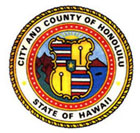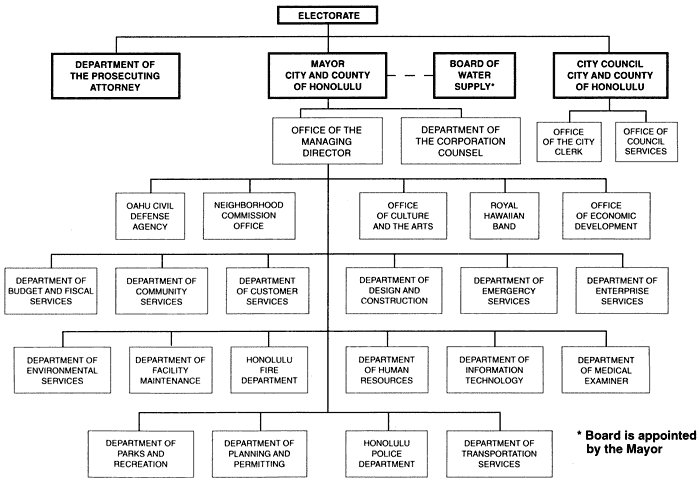City & County of Honolulu
|
|

The City & County of Honolulu is the official municipal and cultural entity of the combined urban district of Honolulu and the rest of Honolulu County in the State of Hawai'i, as prescribed in the city charter adopted in 1907 and accepted by the Legislature of the Territory of Hawai'i. It acts as a public corporation that manages various aspects of traditional municipal governance primarily in the American manner. Over the course of its history, it has morphed into an entity that today is used as a modern model of municipal governance throughout the world.
| Contents |
Government
The government of the City & County of Honolulu is simplified and streamlined and coalesces at three major divisions of municipal power.
- The Mayor of Honolulu is the principal executor of administrative authority and wields highly centralized abilities which in most cities are weighted more equally between the mayor and legislature. Because of the nature of these abilities, the Mayor of Honolulu is often considered by political scientists as one of the most powerful mayors in the nation.
- The Honolulu City Council is the unicameral legislative body. Its elected members are responsible for drafting and passing laws, as well as proposing budgets for various departments. Unlike other cities in the United States, the council is absolutely independent of the mayor, who does not make any appearances during any of the council sessions.
- Likewise, the Prosecuting Attorney of Honolulu is absolutely independent of the other two major divisions of municipal power, and is not responsible for providing legal counsel to those bodies. (This duty is a responsibility of the Department of Corporation Counsel, which reports to the mayor.)
Structure
Districts
Like most cities in the United States, the City & County of Honolulu is divided into smaller administrative districts. There are nine such districts, each of which elects a member of the City Council. The boundaries of each district are revised every ten years in conjunction with the U.S. Census. Each district is composed of unincorporated subdivisions unofficially called towns and cities.
- DISTRICT I: Ewa, Ewa Beach, Honouliuli, West Loch, Kapolei, Kalaeloa, Honokai Hale and Nanakai Gardens, Ko'Olina, Nanakuli, Wai'anae, Makaha, Keaau, Makua.
- DISTRICT II: Mililani Mauka, Wahiawa, Whitmore Village, Mokuleia, Waialua, Haleiwa, Waimea, Pupukea, Sunset Beach, Kahuku, Laie, Hauula, Punaluu, Kahana, Kaaawa, Kualoa, Waiahole, Kahaluu, Ahuimanu, Heeia.
- DISTRICT III: Waimanalo, Kailua, Kaneohe.
- DISTRICT IV: Hawaii Kai, Kuliouou, Niu Valley, Aina Haina, Wailupe, Waialae-Iki, Kalani Valley, Kahala, Wilhemina Rise, a portion of Kapahulu, a portion of Kaimuki, Diamond Head, Waikiki, Ala Moana.
- DISTRICT V: Kapahulu, Kaimuki, Palolo Valley, St. Louis Heights, Manoa, Moiliili, Mc Cully, Kakaako, Ala Moana, Makiki.
- DISTRICT VI: Makiki, downtown Honolulu, Punchbowl, Liliha, Pauoa Valley, Nuuanu, Alewa Heights, Papakolea, Kalihi Valley, Kalihi.
- DISTRICT VII: Kalihi, Kapalama, Palama, Iwilei, Sand Island, Mapunapuna, Airport, Hickam, Pearl Harbor, Ford Island, Aliamanu, Salt Lake, Foster Village, Stadium, Halawa Valley Estates.
- DISTRICT VIII: Fort Shafter, Moanalua, Halawa, Aiea, Pearl City, Pearl City, Seaview, Crestview, Waipio Gentry.
- DISTRICT IX: Waikele, Waipahu, Village Park, Makakilo, Kunia, Mililani.
Civic Center
The civic center is coextensive with what is known as the Capitol District in downtown Honolulu. The official seat of governance for the City & County of Honolulu is located within the district at Honolulu Hale, established in the 1920s as a city hall structure and houses the chambers of the Mayor of Honolulu and the Honolulu City Council. In the 1960s and 1970s, Mayor Frank Fasi developed the modern civic center as it is known today. He took to controversial and aggressive measures to reclaim property, demolish massive concrete structures in the area, construct underground parking facilities and open a green campus above ground with manicured lawns and specially commissioned sculpted artwork. He also oversaw the construction of new government buildings to house the departments that fell within mayoral jurisdiction. The most prominent of those new buildings were the Honolulu Municipal Building and Hale Maka'i, the headquarters of the Honolulu Police Department. Civic centers were also constructed off the Capitol District campus including the Kapiolani Bandstand, Neal S. Blaisdell Center and the Waikiki Shell.
Neilsblaisdellarena.jpg
Services
The City & County of Honolulu collects various forms of taxes including a lucrative property tax. Revenue from those taxes are used to provide several services for the residents. The most prominent of those services are:
- Honolulu Board of Water Supply
- Honolulu Fire Department
- Honolulu Police Department
- Honolulu Emergency Medical Services
- The Bus
Culture
The City & County of Honolulu is the principal patronizer of major cultural institutions that it has historically been associated with, including the Honolulu Symphony and the Royal Hawaiian Band. Both were established by Captain Henri Berger. The Honolulu Symphony is the oldest orchestra in the United States, west of the Rocky Mountains. The Royal Hawaiian Band is the oldest municipal band in the nation and also one that is employed full-time.
Honoluluthebus.jpg
Resources
- City & County of Honolulu (http://www.co.honolulu.hi.us/)



